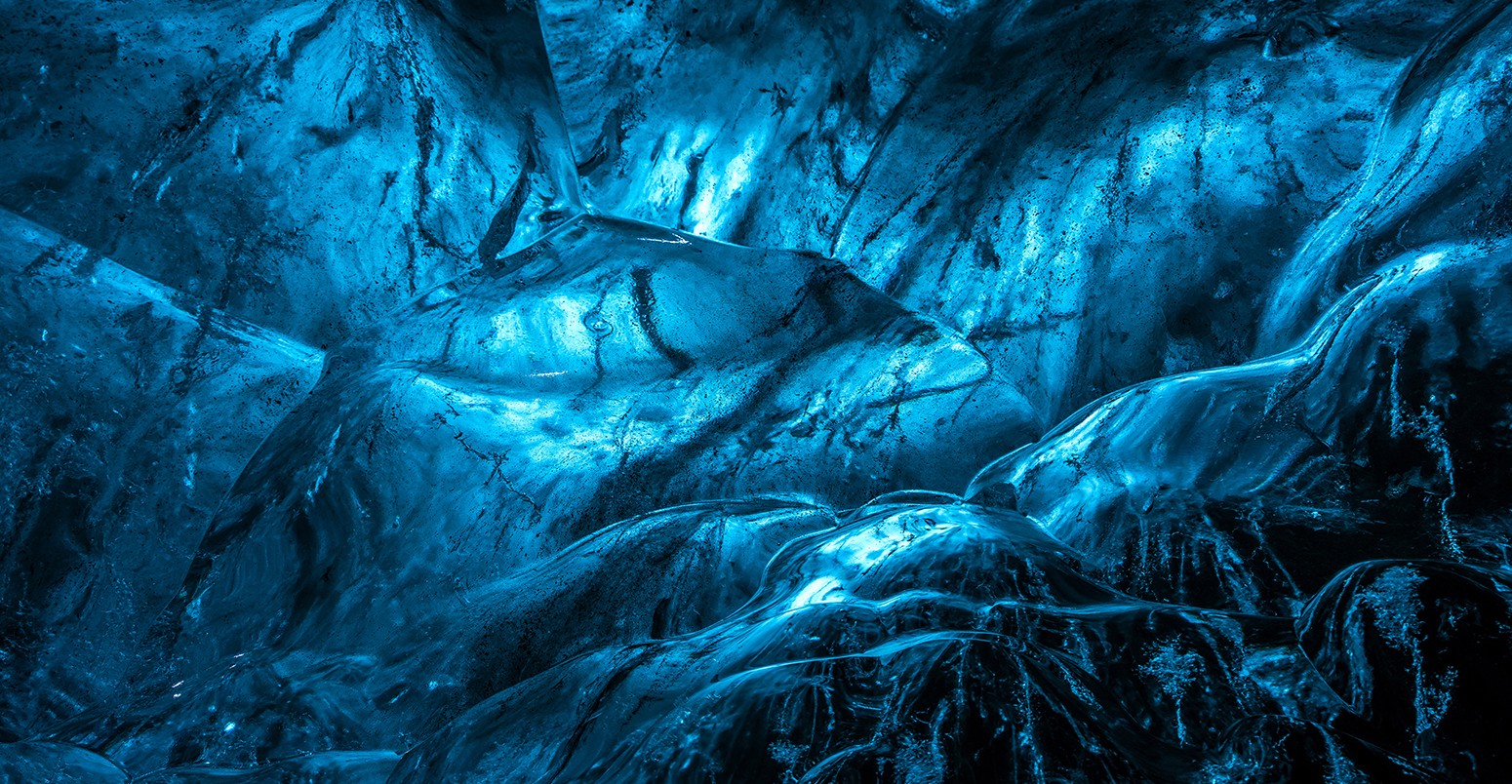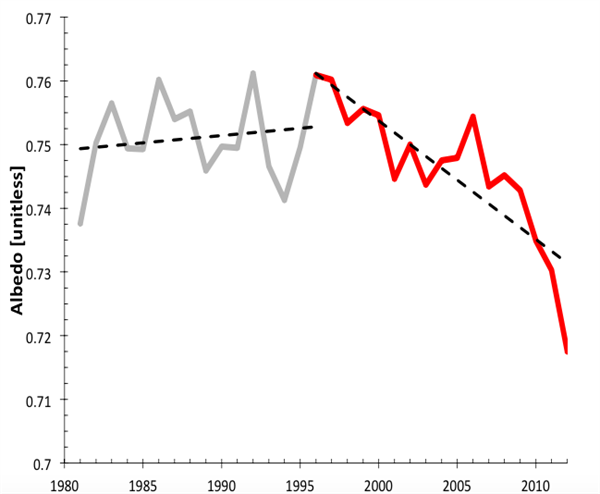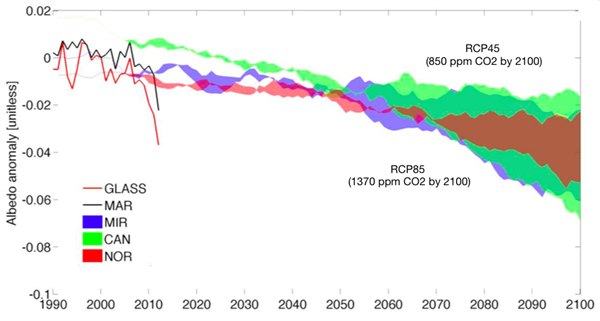
Darkening ice speeds up Greenland melt, new research suggests
Robert McSweeney
04.17.15Robert McSweeney
17.04.2015 | 12:35pmScientists have noticed a curious thing happening as rising temperatures melt the Greenland ice sheet. The ice that’s left is getting darker, making it more susceptible to further melting, according to new research presented at the European Geosciences Union (EGU) conference in Vienna.
Scientists have identified three ways in which the gleaming white ice sheet is getting darker, each contributing to the normally-reflective ice sheet absorbing more of the sun’s energy.
A darkening mood
Second only to the Antarctic ice sheet in terms of size, the Greenland ice sheet spans about 1.7 million square kilometres. This bright white sheet of ice reflects much of the sun’s energy that hits it. This is called the albedo effect, derived from the Latin word ‘albus’, meaning ‘white’. Albedo is measured as a percentage or fraction of the sun’s energy that is reflected.
The albedo effect has a cooling effect on the planet. Ice on land and sea at both poles reflects away energy that would be absorbed had it landed on land and ocean instead.
But in recent years, scientists have found that the Greenland ice sheet is becoming darker. Darker ice absorbs more of the sun’s energy instead of reflecting it away, causing the ice to warm up and melt further.
In an EGU press conference, Prof Marco Tedesco, professor of Earth and Atmospheric Science at the City College of New York presented the graph below, showing that Greenland albedo has decreased significantly since the mid-nineties.
Summer albedo over Greenland. Red line shows decreasing albedo (darkening) between 1996 and 2012. Dotted lines show the trend. Source: Tedesco et al. (2015)
This decreasing albedo coincides with the rate of temperature rise on Greenland speeding up, says Tedesco. Average Greenland temperatures rose by around 0.1C per decade in the 1980s and 1990s, and by 0.74C per decade from the late nineties to present, he says.
Decreasing albedo
The darkening ice sheet is predominantly caused by three factors, all of which are triggered by the melting caused by rising temperatures, Tedesco says. First, changes to the size of individual snow ‘grains’, which are very small crystals of snow:
“When you have new snow, it’s very bright. As you go through melting and refreezing cycles, the grains get bigger and bigger. This creates a reduction in albedo.”
This is actually invisible to the human eye, Tedesco says, so you couldn’t tell it was happening from just looking at the ice sheet.
Secondly, as more snow melts, it exposes the ice underneath, which has a lower albedo. New snow has an albedo of about 80% but for bare ice this is more like 30 or 40%, says Tedesco.
Lastly, snow on the ice sheet contains particles of dust and soot. When the snow on the surface of the ice sheet melts, the meltwater filters down through the snow leaving the particles on the surface, and making it darker. This can include particles from many years ago, Tedesco says:
“The more melting you have, the more impurities you deposit on the surface. Not because [there are more] coming from forest fires or the atmosphere, but because you have a cumulative effect of all the impurities that were stored in the snowpack over the previous years or decades being released because of the increased melting.”
Culprit and the victim
The size of snow grains and days with exposed ice have increased between 1996 and 2012, shown by the areas of red and yellow in the bottom row of maps below.
In the top-left map, you can see albedo has decreased around much of Greenland’s coastline over the same period (blue areas). And in the top-right map, the number of days where it’s warm enough for the ice sheet to melt has increased (red and yellow areas).
Maps showing change per decade in albedo (top-left), days with temperature above melting (top-right), snow grain size (bottom-left) and days with exposed ice (bottom-right) between 1996 and 2012. Source: Tedesco et al. (2015)
Melting of the ice sheet is both a cause and a consequence of these three processes, Tedesco explains. As the ice sheet melts, its albedo decreases, which means it absorbs more energy, causing it to warm and melt even more. He says:
“Melting is a culprit, because it’s creating all these changes in the physical processes of snow, but it’s also the victim.”
The changes are largest along the western edge of Greenland, Tedesco tells Carbon Brief:
“Southwest Greenland has been experiencing enhanced melting more than any other place. Hence, the impact on grain size and impurities is higher than other places.”
Projections
Tedesco and his colleagues used models to see how Greenland ice sheet albedo could change in the future. Model projections suggest the ice sheet will continue to darken over this century. All the models and scenarios Tedesco ran showed a decrease in albedo, as you can see in the graph below. Brown shaded areas are where the projections overlap.
Observed and projected change in Greenland albedo changes, from 1990 to 2100. Red line shows satellite observations, and black line shows how the models reproduce the satellite observations (as a test of their accuracy). Blue, light green and red areas show albedo projections for three models, shading shows spread of results between a moderate (RCP4.5) and high emissions scenario (RCP8.5). Brown, dark green and purple areas show where the projections from different models overlap. Source: Tedesco et al. (2015).
The projections only account for the increasing grain size and exposure of bare ice, not the increase in particles of dust and soot on the surface. This means the projections probably underestimate the drop in albedo over this century, Tedesco says.
The satellite observations (red line) shows the albedo dropped very low in 2012, which was a record melt year for Greenland. Data collected since then suggest albedo has recovered in the last two years, with albedo in 2014 around the same level as 2011.
There are many processes that contribute to ice melt on Greenland, and Tedesco says his team can’t yet calculate the specific contribution from the ice sheet getting darker. But they hope to in time for next year’s EGU, he says.
Melting of Greenland’s ice sheet, and other land ice, contributes to sea level rise. Between 1993 and 2010, Greenland’s ice sheet added around 0.33 mm per year to global sea levels, according to the latest Intergovernmental Panel on Climate Change (IPCC) report. This equates to around 12% of observed total sea level rise in that time.
But under the IPCC’s high emissions scenario (RCP8.5), Greenland’s shrinking ice is expected to raise sea levels by a further 12cm by the end of the century. So, scientists will continue to keep a close eye on factors affecting the rate of ice loss, and what role darkening ice might be playing.




